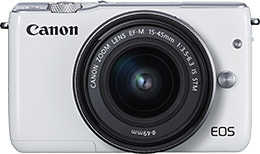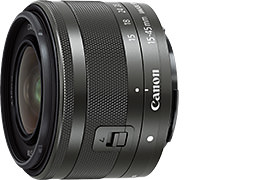Improve Your Travel Photos with the EOS M10 #3: Using a Telephoto Zoom Lens
A telephoto lens lets you take large close-up images of faraway objects that you cannot physically get closer to. You can even use them to close in on a particularly interesting part of the object. In this article, we take a look at how to use a telephoto zoom lens to make your travel and street photos look more amazing than ever. (Photos by: Takeshi Akaogi, Edited by: Etica)

EOS M10/ EF-M55-200mm f/4.5-6.3 IS STM/ FL: 200mm (320mm equivalent)/ Aperture-priority AE (f/8, 1/320 sec, EV±0)/ ISO 320/ WB: Auto
Take a unique photo—close in on interesting faraway subjects with a telephoto zoom lens
A wide angle focal length and a telephoto focal length capture vastly different fields of view
When you come across a scene of interest but are unable to physically move closer, a telephoto zoom lens lets you capture close-up images of the scene, and even fill the entire frame with a fine detail. I took this photo of a building in the middle of a forest, which looked like it was taken straight out of a picture book. Using the shortest focal length of a standard zoom lens, I was able to portray the building standing in the midst of all the greenery. Meanwhile, using the longest focal length of a telephoto zoom lens allowed me to capture a close-up crop of the cutely-shaped window of the building.

EOS M10/ EF-M55-200mm f/4.5-6.3 IS STM/ FL: 200mm (320mm equivalent)/ Aperture-priority AE (f/6.3, 1/320 sec, EV+1)/ ISO 1000/ WB: Auto

EOS M10/ EF-M15-45mm f/3.5-6.3 IS STM/ FL: 24mm (38mm equivalent)/ Aperture-priority AE (f/3.5/ 1/640 sec, EV+0.7)/ ISO 200/ WB: Auto
▼ I depicted the fine details by enlarging a part of the room using the longest focal length of a telephoto lens (left photo). On the other hand, I could portray the vastness of the room in my photo using the shortest focal length of a standard zoom lens (right photo).

EOS M10/ EF-M55-200mm f/4.5-6.3 IS STM/ FL: 200mm (320mm equivalent)/ Aperture-priority AE (f/6.3, 1/40 sec, EV±0)/ ISO 6400/ WB: Auto

EOS M10/ EF-M15-45mm f/3.5-6.3 IS STM/ FL:15mm (24mm equivalent)/ Aperture-priority AE (f/3.5, 1/60 sec, EV±0)/ ISO 1000/ WB: Auto
Portray your subject without distortion using a telephoto lens
One of the characteristics of telephoto lenses is that they can photograph subjects with little to no distortion. Also, since the angle of view is narrower, as the focal length gets longer, the elements in the background will seem to get closer to the subject as if they were right behind it. This effect achieved is due to a phenomenon called the "compression effect". The scenery in the background can change drastically even if the position of the camera is moved only slightly. Thus, another of the characteristics of these lenses is that it tends to cut unnecessary background elements out of the picture.
▼ Compared to the 15mm wide-angle picture (right photo), the 200mm telephoto picture (left photo) was taken with almost no distortion, and the forest in the background looks as if it was right behind the subject.

EOS M10/ EF-M55-200mm f/4.5-6.3 IS STM / FL: 200mm (320mm equivalent)/ Aperture-priority AE (f/6.3/ 1/320 sec, EV+1)/ ISO 320/ WB: Auto

EOS M10/ EF-M15-45mm f/3.5-6.3 IS STM/ FL: 24mm (38mm equivalent)/ Aperture-priority AE (f/3.5, 1/640 sec, EV+1.0)/ ISO 200/ WB: Auto
TIPS: What you should note when using a telephoto lens
One thing to take note of is that images taken using telephoto lenses are especially prone to camera shake. This is because a telephoto lens works by closing in and “enlarging” a subject or part of it, therefore even a small amount of camera shake can be magnified and result in a larger blur. Try to steady your camera properly before you shoot. Also, try to set your image stabilisation setting to "IS Mode - Continuous" from the "IS Settings" section in the menu.


When shooting, firmly grip both sides of the camera tightly and support the camera from the bottom with your left hand. Also, pulling and stretching on the camera strap gives better support and thus more stability while shooting.
This is Part 3 of a series. For previous parts, check out:
#1: Using Bokeh to Isolate Subjects
#2: Using Aperture Settings & Picture Style
For more about the EOS M10, check out this article here:
In Focus: M3 & M10 Techniques and Reviews
To learn more about the EF-M55-200mm f/4.5-6.3 IS STM and what it can do, check out these other articles:
EF-M55-200mm f/4.5-6.3 IS STM Review: A Compact, Reliable Telephoto Zoom Lens
Telephoto Lens Techniques – Creating Multiple Layers of Bokeh
Receive the latest update on photography news, tips and tricks.
Be part of the SNAPSHOT Community.
Sign Up Now!
About the Author
Etica Co., Ltd. not only run photography classes under the name “Tanoshii Camera School", but also edit publications and plan media and events related to cameras and photography, with a focus on themes related to child care, animals and food. Their motto is "Photos make people happy!" and they are engaged in communicating the charm of cameras and photography.
As a photographer, Akaogi works mainly for magazines and writes books introducing photography and practical tips. He also teaches at photography workshops.



































